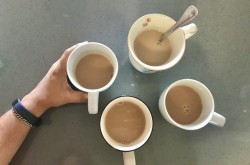Finding creativity and innovation through world travel

Being a historian of technology, by profession and by heart, I always look for examples of human ingenuity during my travels. These creative solutions — which employ available tools and materials — offer a unique glimpse into the lives of communities, the choices they make, and the challenges they face. Here are a few examples.

Nomads, who take their yak herds to the grasslands around Lake Namtso in Tibet, do not have many fuel options.

Their solution is to dry yak dung into patties that can be stored and used for heating and cooking. This is a traditional, easily available, and inexpensive source of fuel, but it does decrease indoor air quality in high altitude — especially in winter.

Can you spot a llama? The caretakers of the Machu Picchu complex in Peru, a fifteenth-century Inca site, use llamas to keep the grass neat and short.

The topography of Machu Picchu makes it difficult to use modern lawnmowers, which would also increase the pollution on the fragile site. Llamas do the job!

This amphibious excavator — or dredger — has a somewhat home-made look. Yet this combination of a boat and a backhoe is perfectly adapted to clearing a small lake in the Summer Palace in Beijing, China.

The community of approximately 2,000 residents of the remote Taquile Island, located on the Peruvian Lake Titicaca, reuses and recycles its limited resources. Hinges of several gates on the island are made from the rubber soles of old shoes.

The Uros islands — which float on Lake Titicaca — are a technology in themselves. They are constructed by the residents of the islands, and have to be constantly maintained. But despite the hardship, the President of one of these islands told us this lifestyle offers residents the ultimate freedom.













